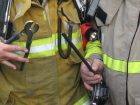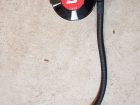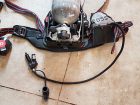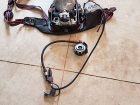
As we continue our study into firefighter survival and self-contained breathing apparatus (SCBA) emergencies, we arrive at the last section – which is equipment failures.
Within this last section, we have four distinct areas that involve equipment failures: straps, buckles and harness; facepiece; hose; and other failures.
We will start with the area that is the least detrimental to the firefighter with his or her SCBA – straps, buckles and harness. On every SCBA we are going to find different styles and variations of straps, buckles and harnesses used to hold the SCBA to the user. Regardless of the style and look, they all must be able to withstand the rigors of our work environment. This will include using Kevlar for heat and cut resistance on the straps and harnesses and metal buckles or high temperature resistant plastic buckles.
With regards to the buckles and straps – there are two main areas that we are going to use these, and they are shoulder straps and waist belt.
If we were to experience a shoulder-strap failure and the SCBA was to be limping off one side, it is not an immediate danger to life situation. Nor would it be if the buckles of the waist belt were to come apart, or if the strap of the waist belt disappeared. These items are important, but do not contribute to the immediate threat to life. What it can lead to are more serious problems if not addressed right away – this will be dictated by the situation and the user and his or her comfort level with the situation.
With the harness, we can have a significant event if the SCBA backplate was to come apart from the harness. This would cause the SCBA cylinder and backplate to fall off the firefighter’s back with the possibility of pulling on the low-pressure hose that feeds the facepiece. This would require immediate attention and evacuation by the user as well as a mayday call. The firefighter can hold his or her cylinder and backplate assembly in his or her hands while he or she makes his or her way out.
The second area of concern is the facepiece. With this piece of equipment, any failure of any kind is life-threatening and requires immediate action. The possibilities are the straps of the mask breaking or coming apart from the mask, or the lens of the mask breaking or melting. If either of these were to occur, the facepiece would be compromised and will not protect the firefighter on its own.
If the straps break, the firefighter will need to hold the mask to his or her face while he or she makes his or her way out. The seal of the mask can be maintained in order to have air exchange without compromise from outside contaminates. A mayday will certainly need to be called, but the firefighter can exit the structure on his or her own if he or she is not physically impaired.
If the lens of the mask either melts or breaks, this is going to be a very serious issue to deal with. A lens that melts means that we have extreme temperatures and possibly have experienced a rapid-fire development situation. The firefighter will certainly be exposed to the high heat and will most likely have inhaled a breath or two of the superheated gases.
The firefighter will need to cover his or her face with the hands if possible, call for a mayday and try to make his or her way out. This may involve getting on his or her belly and pushing along the wall with his or her feet so that the hands can keep the mask covered.
A broken lens may be the result of contact with an object that fell on the firefighter. This will also expose the firefighter to the environment that will be around him or her, which may be superheated or not so superheated. Either way, the firefighter will inhale a few breaths of contaminated air.
The firefighter will have to cover his or her facepiece with the hands and call a mayday. If the individual can exit the area and building, he or she should do so or wait for the rapid intervention team to come or another crew that can assist.
The third area involves hose failures. These fall into two categories – low-pressure and high-pressure hoses. With the low-pressure hoses, you will not notice the leak or failure right away, unless the low-pressure hose has been cut in half. With a low-pressure hose compromised, a firefighter will need to exit the area immediately. The way to know that there is a leak is by watching your air supply on the shoulder gauge or by hearing it if it is audible enough.
With the high-pressure hose, this will be noticeable right away – it will be leaking air and making a noise that can be heard by the firefighter or by the other crew members. When this happens, it may require a firefighter to control the flow of air by turning off and on his or her cylinder. This will allow the firefighter to conserve air while he or she exits the structure. A mayday call will certainly be required.
The last area is dealing with any other failures like being out of air or if the regulator stops working. If the regulator stops working, a firefighter will need to operate the bypass valve to open and close it. This will be done intermittently, allowing the firefighter to take a breath, hold it, then exhale it ready for another one. The bypass valve will be opened to take the breath in.
When a firefighter is out of air, this is an immediate life-threatening situation. He or she needs to get some air or else the individual won’t live. The reasons for why firefighters are out of air are not going to be discussed, but if this were to occur the firefighter would need to take some evasive action. This may include getting to a window so that the firefighter can take off his or her mask and breathe the outside air or buddy breathe with a partner.
Buddy breathing can either be done by one firefighter taking the regulator out from his or her mask, covering the opening of the mask with a hand, passing it to the other firefighter so that he or she can put it into his or her mask, take a breath, then pass it back to the original firefighter while covering his or her opening with a hand. This operation is very evasive and unorthodox, but it will allow a firefighter to have some air to get him or her out of a building.
The other method involves using the emergency breathing support system (EBSS). This system offers a couple of options for the firefighter to use: connect both EBSS systems together or connect the one regulator to the EBSS. This will allow both firefighters to exit the structure while breathing off one cylinder.
Mark van der Feyst has been in the fire service since 1999 and is currently a full-time firefighter with the WFD. Mark is an international instructor. He can be contacted at Mark@FireStarTraining.com.
Print this page



